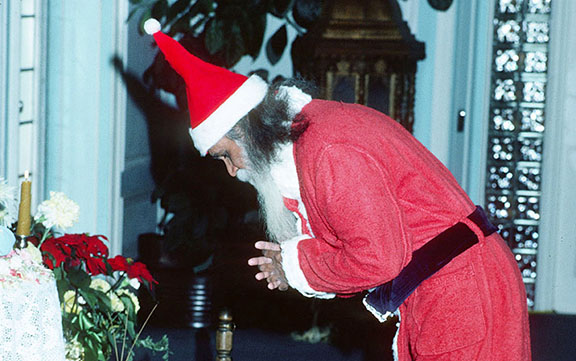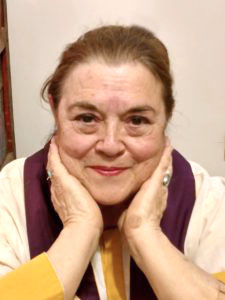
(photo: Swami Satchidananda dressed as Santa during Christmas festivites. Here, he pays his respects to the altar in Yogaville East, mid-1970s.)
I sit looking at my Christmas tree, which for the first time since I moved to Yogaville (several decades ago!) was not decorated by the swamis (monks) who live here. It was a strange and sad experience (due to the pandemic) doing it myself, but a sweet, tall angel came and put the angel on the top where she belongs. I think of my first Yogaville Christmas—magic in more ways than the happy time of inviting all the monks to come to a big Christmas dessert buffet and to decorate the tree. I had invited Sri Gurudev Swami Satchidananda as well. After all, he too was a monk—not just a monk, but the personage I believed and still believe to be most aligned with the very reason for the season of anyone in my lifetime! He wasn’t able to come, but he said gently, “I’ll be there in spirit.”
We have one monk who is, like my grandfather and myself, a Christmas tree aficionado. So, that Christmas, long after everyone else had done the merry deed and stopped for refreshment or carols, this wee wizardess would scrutinize the tree and make adjustments. If an ornament was stained glass, it should have a bulb right behind it so that the light would shine through. If there were too many ornaments of the color red together in one place, they would be divided up across the boughs.
This year there was one angel who simply refused to settle in a perfect place, so my swami artist friend moved her all over the tree. After a while, we all started razzing her good-naturedly. “No, no, just leave it where it is! Come get some goodies! Enough!” She was not to be deterred. Finally, finally the angel took center stage in the very center of the tree, equidistant between the top and bottom, between the left side and right side. With a great sigh of satisfaction, my swami friend came to the sofa and took a plate of Christmas goodies.
Why so much attention to this rite of the re-do? Because the very next night Sri Gurudev came to see the tree. In his hand was a small gift bag. He handed it to me with a merry, mischievous smile and said, “It’s for the Christmas tree, so go ahead and open it. You can put it beside Vidyananda’s angel!” He laughed fondly. For a moment I didn’t catch on, and then suddenly it occurred to me: Wait a minute! Nobody would have reported such a detail to him—that it was Vidyananda who arranged that angel just perfectly! I looked at him with inquiry and amazement. “You came!” I stuttered. “You came in spirit, just as you said you would, didn’t you? Laying a finger beside of his nose he gave a little nod!
The tree, fabulous every year afterward, always invites the story to be told and reliving the warmth and appreciation of my finding out for sure what an avatar truly is. And how closely one can be involved in any loving magic that warms the hearts of those who seek the light—or try to create the perfect place for an angel to rest for a little temporal exchange with her beloved human family.
This year, as we approached Sri Gurudev’s birthday (December 22) and Christmas, I lovingly touched the ornament he had given me so many years ago and I made sure Vidyananda’s angel had a light on her sweet face and light behind her wings. I must admit, I get a little teary missing, yet celebrating, the way we were…
About the Author:
 Rev. Dhyani Simonini is a longtime student of Sri Swami Satchidananda. She became an Integral Yoga Minister in 1990. She retired from Buckingham County High School, where she taught English, drama, and speech for 31 years and was instrumental in establishing the operation of a student-owned touring theatre company that specialized in public service tours. She serves as captain of the Disaster Action Team (DAT) for Buckingham County through the American Red Cross. Her lifelong love of Native American spirituality led her to become involved with a phonetic transcription of the sacred songs and rituals. She transcribed for Walker Calhoun, sacred firekeeper of the Cherokee nation, and for Doris Riverbird Woman, clan mother of the Lenape nation, who later adopted her and made her legal representative for “all things Native American.” She created a Native American medicine wheel on her property which she hopes will serve as a gathering place for Native ceremonies and, later, intends to create a center for indigenous people on the property.
Rev. Dhyani Simonini is a longtime student of Sri Swami Satchidananda. She became an Integral Yoga Minister in 1990. She retired from Buckingham County High School, where she taught English, drama, and speech for 31 years and was instrumental in establishing the operation of a student-owned touring theatre company that specialized in public service tours. She serves as captain of the Disaster Action Team (DAT) for Buckingham County through the American Red Cross. Her lifelong love of Native American spirituality led her to become involved with a phonetic transcription of the sacred songs and rituals. She transcribed for Walker Calhoun, sacred firekeeper of the Cherokee nation, and for Doris Riverbird Woman, clan mother of the Lenape nation, who later adopted her and made her legal representative for “all things Native American.” She created a Native American medicine wheel on her property which she hopes will serve as a gathering place for Native ceremonies and, later, intends to create a center for indigenous people on the property.

